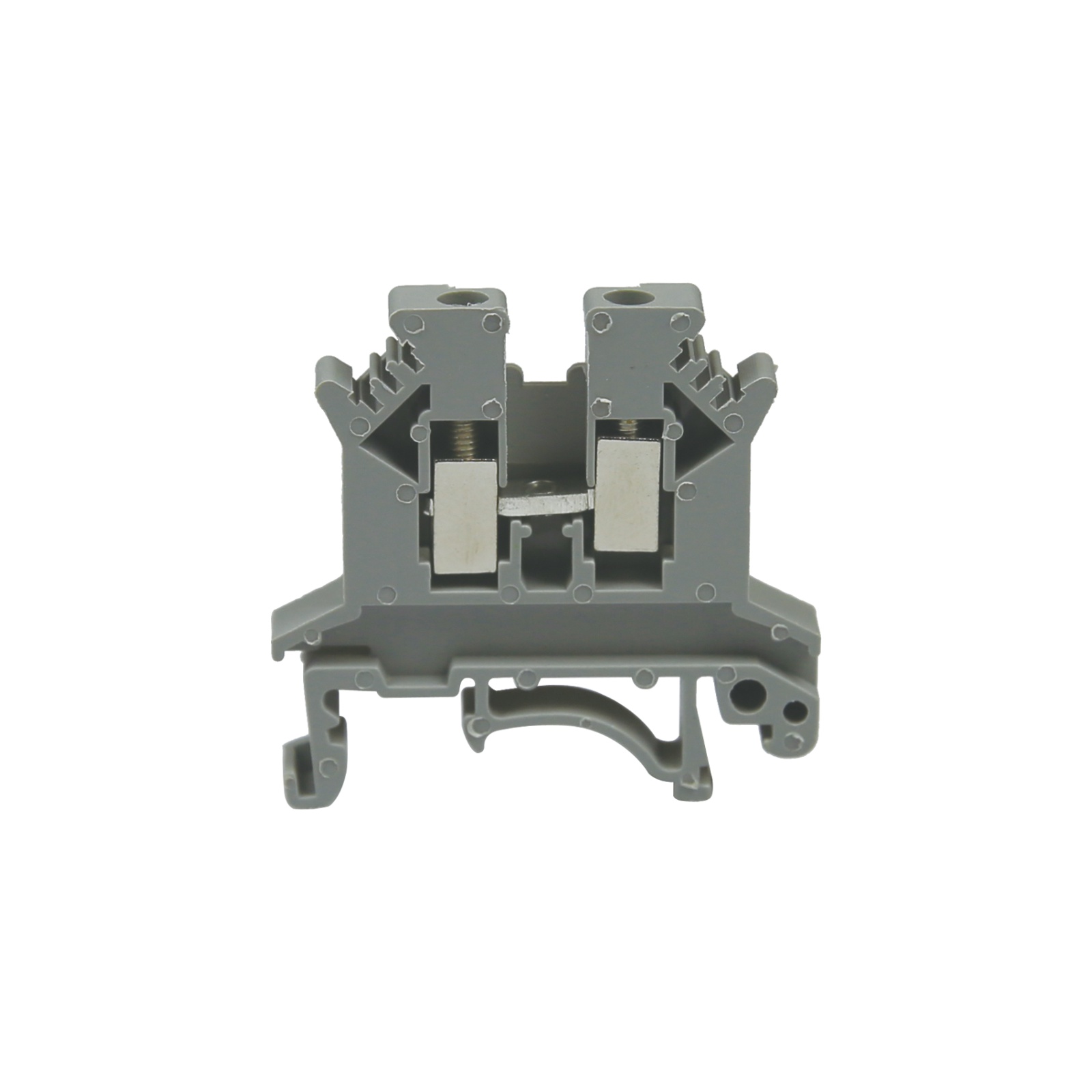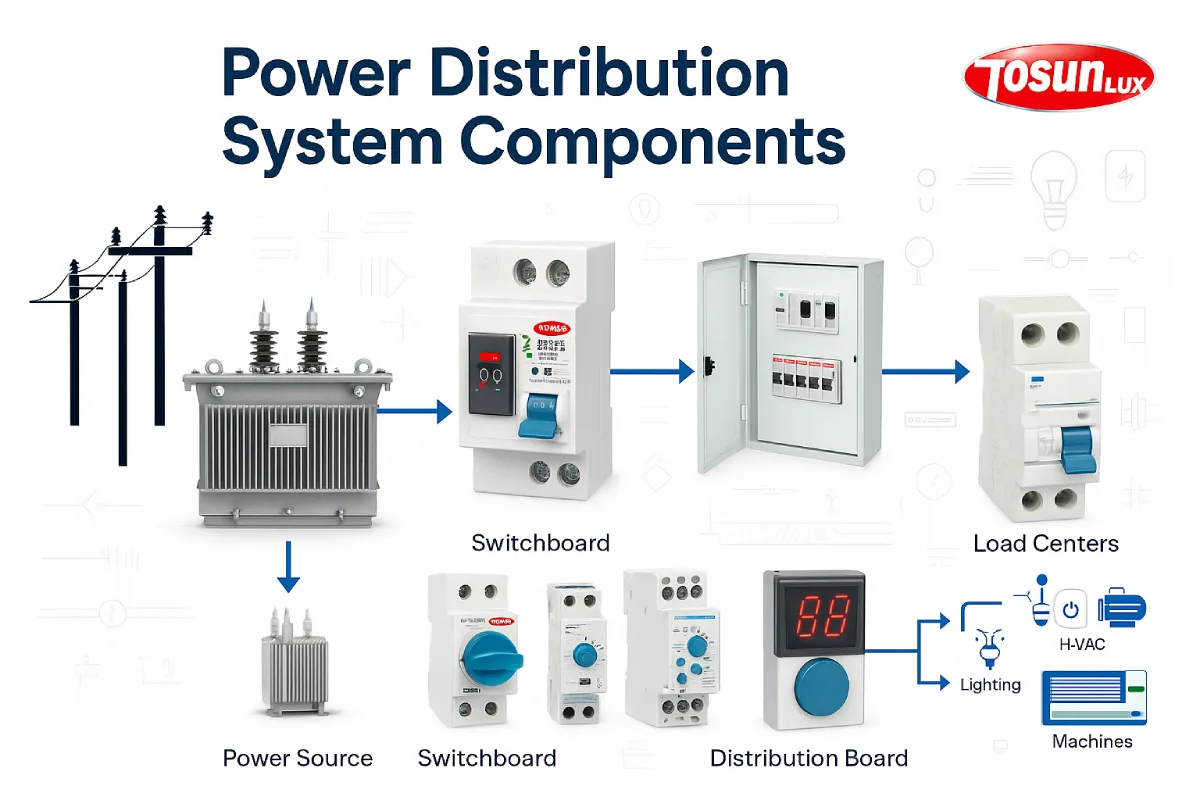How to Choose the Right Terminal Block
ማውጫ
ቀያይርChoosing the right terminal block requires matching voltage and current ratings to your system requirements, selecting an appropriate wire entry style, and considering the mounting method. Match the wire gauge capacity to your conductors and verify the block meets relevant safety standards for your application.
What Do Terminal Blocks Do?
Terminal blocks create secure, organized connections between wires without permanent splicing. They use mechanical clamping to hold conductors together inside an insulated housing. You’ll find them in industrial equipment where control wiring needs organized connection points.
How Do Terminal Blocks Work?
A terminal block clamps wire conductors against metal terminals using mechanical force. Insert a wire into the terminal opening and tighten the clamping mechanism. This creates a gas-tight connection that conducts electricity reliably while holding the conductor firmly in place.
The insulated housing keeps adjacent connections separated. You can connect multiple wires to the same block without creating direct contact between circuits. This allows you to inspect or modify individual connections without affecting others.
Terminal Block Types
Terminal blocks vary based on mounting method, wire entry style, and clamping mechanism. Here are the main types:
- PCB Mount Terminal BlocksPCB mount blocks solder directly to printed circuit boards. Wires insert from above and clamp securely in the housing. Control panels use them to connect external wiring to circuit boards without requiring direct soldering.
- Barrier Strip Terminal BlocksBarrier strips use screw terminals with physical barriers between poles. Ring or spade terminals attach to wires before mounting under the screw. The mechanical connection resists loosening under vibration in industrial equipment and motor control applications.
- DIN Rail Terminal BlocksDIN rail blocks snap onto standard 35mm rail inside enclosures. Feed-through style blocks create wire-to-wire connections. Ground types connect conductors to the rail for system grounding. Multiple blocks slide together on the rail for organized, high-density wiring.
- Pluggable Terminal BlocksPluggable types separate into plug and receptacle halves. Wires terminate in the plug portion, which disconnects from the fixed receptacle. This simplifies equipment removal since you disconnect one plug instead of unwiring individual conductors.
How do I choose the Right Terminal Block?
Choosing a terminal block becomes easier when you evaluate things in order. Here’s what to consider:

UK Terminal Block (Modular)
- Modular DIN Rail Mounting
- High-Insulation Housing (PA66)
- Secure Screw Clamp Connection
- IEC Certified for Reliability
Step 1: Calculate Current and Voltage Requirements
Start by figuring out the maximum current your circuit will carry. Select a terminal block rated for at least 150% of that value. A 10A circuit needs a 15A terminal minimum. This prevents overheating during brief overloads.
Check your system’s voltage. Low voltage terminal block applications operate below 1000V. The terminal’s voltage rating must exceed your highest system voltage. Add margin for voltage spikes if you have motors or switching equipment.
| Terminal Block Type | Typical Current Range | Typical Voltage Range | የተለመዱ መተግበሪያዎች |
|---|---|---|---|
| PCB Mount | 10-30A | 300-600V | Control boards, instrumentation |
| Barrier Strip | 15-600A | 300-1000V | Motor connections, high-power circuits |
| DIN Rail | 6-150A | 500-1000V | Control panels, distribution boxes |
| Pluggable | 10-20A | 250-630V | Field-serviceable connections |
Step 2: Select Type Based on Mounting Location
Pick your mounting method based on where the terminals will be installed. PCB mount blocks work when connecting to circuit boards. DIN rail blocks fit inside control cabinets on 35mm rail. Panel mount blocks attach directly to custom enclosures.
Consider wire entry direction for your available space. Horizontal (90°) entry brings wires perpendicular to the mounting surface. Vertical (180°) entry runs parallel. Some blocks offer 45° entry between these orientations.
Step 3: Match Wire Specifications
Terminal blocks list the wire sizes they accept. North American systems use AWG numbers while international specs use mm². Your wire gauge must fit within the terminal’s specified range.
Check your wire type:
- Solid wire works with most terminal types
- Stranded wire needs terminals designed for flexible conductors
- Undersized terminals won’t grip thin wires properly
- Oversized wires won’t fit the terminal opening
Count how many circuits you’re connecting at each location. This determines the pole count you need. A 6-pole block handles six separate circuits in one housing.
Step 4: Choose Clamping Style
Two main clamping styles are available: screw terminals and spring clamps. Both secure wires differently based on how you install them.
ሀ Screw terminal block uses a threaded screw to tighten a clamp onto the wire. They work best in machines that vibrate because the mechanical connection stays tight. You can use them with solid or stranded wire.
Spring clamps speed installation when you need fast wiring or frequent circuit changes. Push-button types have a release that opens the clamp for wire insertion. Push-in types accept wire directly without tools. Both styles work best with solid conductors since stranded wire may not grip as securely.

PT In-Line Spring Terminal Block
- Tool-Free Push-In Technology
- Fast & Secure Vibration-Proof Wiring
- Modular DIN Rail Mounting
- Ideal for High-Density Control Panels
Step 5: Verify Safety Certifications
When selecting a terminal block, make sure that it meets the required safety certifications for your region: UL (North America) or IEC (international). These certifications ensure the block has been tested for electrical safety and long-term reliability.
Also check the materials:
- Housing/insulation should be flame-retardant (e.g., UL94V-0 rating), so it won’t continue burning if exposed to heat.
- Contacts should be made of copper or brass, as these materials conduct electricity efficiently and resist corrosion.
Choosing certified materials helps prevent overheating, electrical faults, and premature failure in the field.
What Are the Disadvantages of Terminal Blocks?
Terminal blocks require more panel space than direct splicing. Installation takes longer than wire nuts. You need proper tools and techniques to avoid loose connections.
Other drawbacks include:
- Higher initial cost than wire nuts or crimp splices
- Connection points that can develop resistance without maintenance
- Spring clamps that may not grip certain wire types securely
- Reduced wire size capacity when using multiple wires per terminal
Screw terminals need proper torque to prevent loose connections. Over-tightening damages wire strands while under-tightening creates loose connections.
TOSUNlux Terminal Block Solutions
TOSUNlux manufactures terminal blocks suitable for control cabinets, distribution boxes, and industrial automation equipment. Our products work with our MCB, MCCB, and RCCB circuit protection devices for complete panel solutions.
Our range includes:
- DIN rail mounting types for organized cabinet wiring
- Busbar terminals for high-current distribution
- UK-style blocks for standard applications
- Spring terminals for faster installation
These AC terminal block options suit both control circuits and power distribution in low-voltage systems. Our terminal blocks meet IEC standards with proper certifications. We manufacture at our Wenzhou facility with quality control throughout production.

ማበጠሪያ Busbar
- Efficient High-Current Distribution
- Optimizes Panel Space & Wiring
- Fast Connection to Modular Devices
- Essential for Complete Panel Solutions
ማጠቃለያ
Choosing a terminal block is really just matching the block to the job. You look at the load, the wire size, and where it will be installed. Once those are clear, picking the right style becomes easy. When the block fits the application, you get safe, stable connections without overthinking it.
Looking for a One-Stop LED Lighting Solution?
With 30 years of certified manufacturing, we are the trusted partner for your complete industrial and commercial lighting needs.
ስልክ፡ +86-577-88671000
ኢሜል፡- ceo@tosun.com
ስካይፕ: የፀሐይ ኤሌክትሪክ
Wechat፡ + 86-139 6881 9286
WhatsApp: + 86-139 0587 7291
አድራሻ: ክፍል ቁጥር 1001 Wenzhou Fortune ማዕከል, ጣቢያ መንገድ, Wenzhou, ቻይና
ጥቅስ ጠይቅ
WhatsApp እኛን
 : +86-139 0587 7291
: +86-139 0587 7291 እንግሊዝኛ
እንግሊዝኛ ኢስፓኞል
ኢስፓኞል ሩስስኪ
ሩስስኪ ፍራንሷ
ፍራንሷ العربية
العربية ፖርቱጋል ዶ ብራሲል
ፖርቱጋል ዶ ብራሲል Українська
Українська ቱርክሴ
ቱርክሴ ፖልስኪ
ፖልስኪ ኔደርላንድስ
ኔደርላንድስ ጣሊያናዊ
ጣሊያናዊ ባሃሳ ኢንዶኔዥያ
ባሃሳ ኢንዶኔዥያ ኤችአይቪ
ኤችአይቪ اردو
اردو ንህዝቢ ትግራይ ንህዝቢ ትግራይ ንህዝቢ ትግራይ ንህዝቢ ኤርትራ ንህዝቢ ምውሳድ ምውሳድ እዩ።
ንህዝቢ ትግራይ ንህዝቢ ትግራይ ንህዝቢ ትግራይ ንህዝቢ ኤርትራ ንህዝቢ ምውሳድ ምውሳድ እዩ። Հայերեն
Հայերեն እ.ኤ.አ
እ.ኤ.አ ሞንጎል።
ሞንጎል። ፋርሲ
ፋርሲ ሽኪፕ
ሽኪፕ Ελληνικά
Ελληνικά


